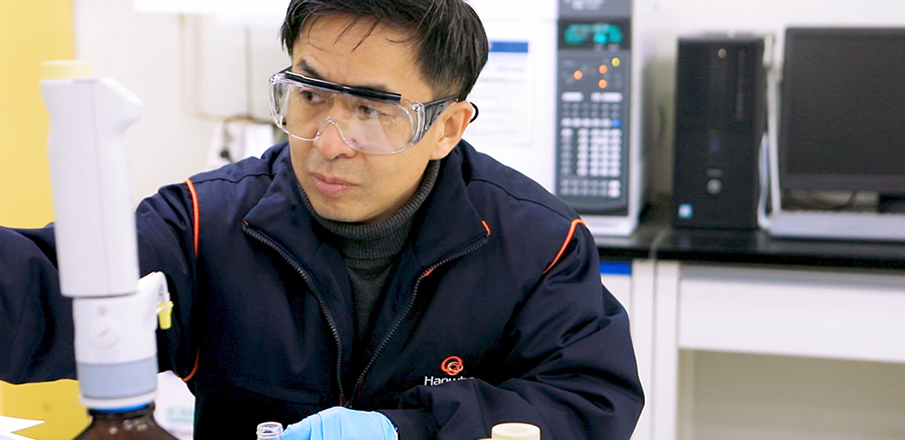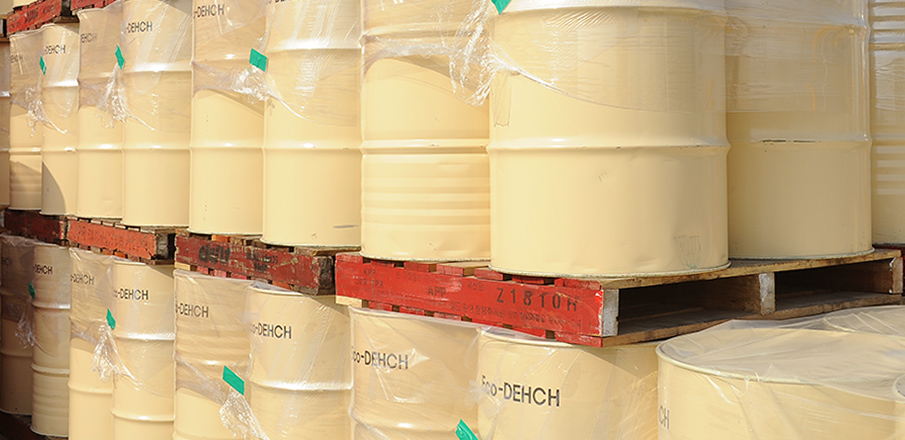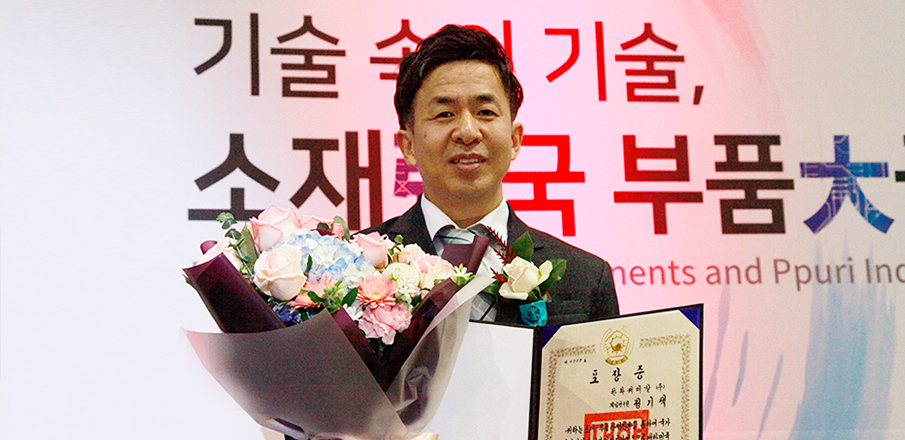Meet the Team: Hanwha Solutions’ Kitaeg Jung

Principal research engineer Kitaeg Jung describes himself as a problem solver who is always looking for the best solution, not just any solution.
When consumers began demanding safer plastics, produced without plasticizers¹ containing phthalates², the chemical industry struggled to find suitable solutions. Kitaeg and his team dedicated themselves to developing a breakthrough: ECO-DEHCH³, an environmentally sustainable plasticizer that is non-toxic, without sacrificing product quality.
Kitaeg reflects on the challenges he and his team faced during development, efforts they made to address problems along the way, and gratification he felt when he received one of Korea’s most prestigious industrial research awards.
- Q1. Could you please introduce yourself?
-
My name is Kitaeg Jung and I’m a principal research engineer overseeing chemical processes at Hanwha Solutions. I joined Hanwha 15 years ago in 2005.
I’m currently in charge of ECO-DEHCH development. I also conduct research on new products and processes here at the lab.
- Q2. What sort of research have you been conducting?
-
My focus is on developing sustainable production processes that can reduce waste and are more efficient. For instance, my team and I developed ways to reduce wastewater output down to 1/50th, or even 1/100th, of that of current production techniques.
We’re also working on ways to recover organic compounds from wastewater and looking into next-generation energy sources like fuel cells.

Kitaeg Jung at work in his lab
- Q3. Have you always been concerned about the environment?
-
I’ve been interested in the environment since I was a child. So, it’s great to see people becoming more aware of environmental issues.
Now, I take my children out to nature parks and volunteer for clean-up activities to show them the importance of preserving the environment.
- Q4. How did you develop an environmentally sustainable plasticizer?
-
To be frank, there were concerns over the toxicity of traditional phthalate plasticizers in Korea and other developed nations. Alternatives needed to be found.
It took us about eight years of continuous research to develop ECO-DEHCH. Because existing plasticizers were showing high performance, people were asking questions such as, “Is there space for ECO-DEHCH in the market?” As development progressed, however, the market for environmentally sustainable products grew much faster than anyone had anticipated.
Our biggest challenge was keeping manufacturing costs down. We managed to reduce those costs by about 50% in the end. By then, we were all optimistic about successfully commercializing ECO-DEHCH.

ECO-DEHCH is environmentally sustainable and safe for humans to handle
- Q5. What do you most remember from the eight years you spent working on
ECO-DEHCH? -
During the research phase, one major issue we had was the short shelf life of our catalyst.
This was a dilemma because we were just about ready to put it on the market. I didn’t give up and began digging deeply into where things might have gone wrong. While I was doing this, I found a pattern in our past findings. By examining that pattern and making changes to the details we had overlooked, I was able to improve the catalyst’s shelf life significantly.
Being able to experiment and collaborate with my colleagues to solve a major problem was an exhilarating one that I’ll never forget.
- Q6. Was there ever a moment when you wanted to abandon the project?
-
Research always includes unwanted results. I’m able to work through those frustrations thanks to my faith in my colleagues. They were all so supportive and encouraging throughout the eight years we worked on ECO-DEHCH, so I never gave up and was able to see it through to completion.

- Q7. What was key to the successful development of ECO-DEHCH?
-
I think there is one key, which is the “question mark” that we put on the end of everything that we do.
What I mean is that we never simply accepted satisfactory results and moved on. We kept asking questions and strived to get even better results. By doing this, we discovered a lot of unexpected issues that needed to be addressed.
One of my key beliefs is that every problem has a solution. We were able to make ECO-DEHCH a success by constantly questioning and searching for problems and their solutions.
- Q8. How did it feel when the Korea Industrial Technology Association presented you with the “IR52 Jang Young-shil Award ” for developing ECO-DEHCH?
-
As a researcher working on environmentally sustainable projects, it was a dream come true to receive such a prestigious award. I felt that it wasn’t just in recognition of our successful research, but also the growth and necessity of environmentally sustainable industries in Korea.
It was gratifying to see how excited everyone else was about the award, especially my colleagues and all the staff at the lab who trusted us to the very end.

Kitaeg Jung received one of Korea’s most prestigious industrial research awards for his work on ECO-DEHCH
- Q9. How do you see your achievements contributing to sustainability?
-
The commercialization of ECO-DEHCH is important in several ways. The most important thing is that chemical companies now must think of environmental sustainability on top of product performance. Because of this, I believe Hanwha Solutions and ECO-DEHCH kicked off an environmentally sustainable transformation in the chemical industry.
- Q10. What do you think the future of plastics will be?
-
In the future, I believe we’ll see regulations put into place that will require plastics manufacturers to dedicate a portion of their output to environmentally sustainable products.
Chemical companies are already required to meet environmentally sustainable product quotas. I expect that this practice will have a huge impact on how chemical companies implement sustainable policies.
- Q11. Are you working on any other environmentally sustainable projects now?
-
We’ve begun researching biochemistry and biodegradable polymers, which are two environmentally sustainable areas that are getting a lot of attention in the chemical industry.
ECO-DEHCH was just the beginning for us. We’re going to keep improving our technical capabilities and commercial viability to make sure environmentally sustainable products are more widely used.
- Q12. What is the “spark” that drives you?
-
I’m driven by perseverance and passion to continue discovering problems that need solutions. As I said before, every problem has a solution. You may already have a solution, but it might not be the best one. There may be a better solution if you dig a little deeper.
Also, I think that the compulsion to keep looking for the best solutions is another spark that drives me.
- Q13. And what lights that “spark ”?
-
Research isn’t something you do alone. ECO-DEHCH succeeded because of the amazing support I received from my colleagues and the company.
It was because I received this support that I was able to find the passion to complete this project.
- ¹Plasticizers : Substances used in plastics manufacturing to improve flexibility and reduce brittleness in the final material.
- ²Phthalates : Commonly used plasticizers. Their usage was substantially curbed by governments around the world because of concerns about their toxicity to humans.
- ³ECO-DEHCH : Hanwha Solutions’ proprietary phthalate-free plasticizer. It is non-toxic and environmentally sustainable and can be used in everything from construction materials to food-grade plastic wraps.


